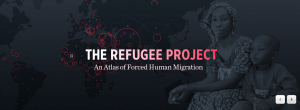We present, in this first of a series of video interviews a tour of some of the sharpest work going on with data visualization in the social sector, spanning large-scale visualization efforts (e.g. for the UNHCR by our first subject, Hyperakt) to Beth Kanter giving another classic brief that leaves no one, regardless of budget size, with an excuse for not find ways to make data visualization work to help you know your data and to tell a compelling story. Please welcome award-winnng producer Greta Knutzen, not only a guest author, but also a guest curator in a drill-down on data visualization. Greta has been exploring the ways in which new digital techniques are expanding the available toolkit for social issue mediamakers and changemakers to create media projects which function as powerful drivers of social change.
…
Ask the Experts
Data visualization is how we bring visual conversation to tables and figures to reveal hard truths hidden in mounds of otherwise boring or undecipherable data. We can then communicate complex and data rich stories of particular value to the full range of social sector entities tackling the worlds most challenging problems.
But where do you start? How do you know if data visualization makes sense for your organization? How do you find the right artist or agency to work with? How much will it cost? What is the process? How do you know which data to use? These are the questions I will put to the artists, design agencies and foundations that have created some of the most ground breaking and impactful data visualizations for social good.
We lead off the series with an interview with Deroy Peraza, Principal and Creative Director at Hyperakt, a design firm in the advance guard that is helping changemakers tell their stories. In this interview, Deroy explains how to find the right artist or agency to work with and outlines the process involved in creating a data visualization.
…
 “Hyperakt is a social impact design studio. Our clients solve the toughest global problems and champion those who have been left behind. We help them to focus messages, make complex information understandable, create new narratives, reinvigorate brands, explain organizational systems, and communicate stories through dynamic data. We know that well-designed stories have the potential to disrupt, transform, and propel action, because we have seen it happen.”
“Hyperakt is a social impact design studio. Our clients solve the toughest global problems and champion those who have been left behind. We help them to focus messages, make complex information understandable, create new narratives, reinvigorate brands, explain organizational systems, and communicate stories through dynamic data. We know that well-designed stories have the potential to disrupt, transform, and propel action, because we have seen it happen.”
The Refugee Project, A Case In Point (credit: Hyperakt)

Stay tuned for more profiles in which the same set of questions will be put to other individuals and firms who are defining the space – with the specfic goal of bringing you much closer to how you can make data visualization work for you.
